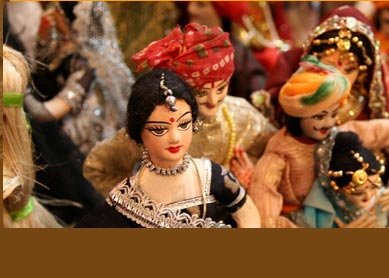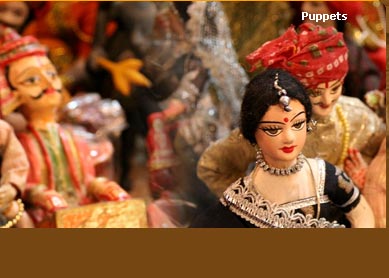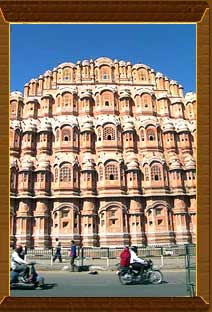

Jaipur: The Pink Marvel

Quick Facts
- Location : Jaipur is the capital city of Rajasthan and is around 258 km from Delhi, a 6 hr ride on the National Highway 8. It's distance from Agra is around 232km. Delhi-Agra-Jaipur form the Golden Triangle in Indian Tourism.
- Climate : Extremely hot and humid climate in summers lent by its close proximity to the Thar Desert. Monsoons are dry while winters are pleasant.
- Known For : Unforgettable and palatial monuments, pink forts and palaces, narrow streets, folk dances and camel rides.
- Best Time for Visit : The winter months of October to March
Major Attractions
Amber Palace :The walled fort of the 16th century served as the capital of the Kachhwaha clan of Rajasthan and was built for the protection of the township that used to reside here. From the outside one can feel the ruggedness of the fort symbolizing protection while the interiors have a strategic design and ornamentation influenced by the Mughal and Rajput architecture for a royal stay that leaves you imagining the bygone era of the royals.
City Palace : The City Palace covers around one-seventh of Jaipur's area and has enticing structures like Mubarak Mahal, Chandra Mahal, Diwan-i-Khaas, Mukut Mahal, Badal Mahal and the Shri Govind Devji Temple. The Mubarak Mahal, presently houses the City Palace museum with artifacts, arms and robes of the royals.
Jantar Mantar : A magnificent observatory is the largest stone observatory in the world. It showcases Maharaja Sawai Jai Singh's love for astronomy and celestial bodies. There are around 18 scientific instruments to study the celestial objects, prepared with great precision and after a lot of study and calculations.
Hawa Mahal :The signature landmark of the city, Hawa Mahal that literally means 'the wind palace' was built for the womenfolk of the palaces to have a view of the happenings on the street it overlooks, through the series of windows called jharokhas, without being noticed. It was built by Maharaja Sawai Pratap Singh in the year 1799. The sun rays falling on the pink monument gives it an ornamental glow and the intricate work on the walls add to the structure's charm.
Fairs And Festivals
Elephant Festival : The grand procession of decorated elephants during March add to the zing to the festival of colors, Holi. The festival is meant for elephants and they dance, play and participate in various competitions like race, tug of war, etc. to express that they are enjoying being the centre of attention.
Teej Festival :The Teej festival is celebrated all over India in the months of July/August, but its the most extravagantly celebrated in this city. The festival is marked by folk songs, swings, dances, sweets and delicacies, colorful attires. It is mainly for the married womenfolk who fast for the wellbeing of their husbands and pray for a blissful married life.
Gangaur Festival :This festival us celebrated in the months of March/April. Gan and Gaur are synonyms of Hindu God Shiva and his wife Goddess Parvati. Parvati symbolizes devotion, fertility and an ideal married woman. Married women conduct prayers for the welness of their husband and unmarried women pray for a good husband. The two week festival ends with a grand celebration on the last day which has traditionally dressed local people, elephants,camels and horses in the form of a huge procession to mark Gauri's departure to Shiva's home.
Religious Centres
Birla Mandir :The famous Lakshminarayan temple with huge and lively statues of Hindu Lord Vishnu and Goddess Lakshmi, built in the year 1988, is a fine architectural marvel presenting the Jaipur culture. It is a temple open for people of all religious and faiths. This temple is fully made of white marble. Both the Birla Mandirs, one in Jaipur and another in Delhi, was built by the Indian Industrialist Group, the Birlas.
Govind Devji Temple :Another principle temple of faith for the Hindu Rajputs, it is devoted to Govind Devji a synonym of Lord Krishna. It contains a spectacular statue of Lord Krishna and Goddess Radha which was brought from Vrindavan in Uttar Pradesh, known as Lord Krishna's hometown. This sacred place was built within the City Palace of Jaipur, was built by Raja Sawai Jai Singh.
Moti Dungri : Moti Dungri literally means 'hill of pearls'. The Moti Dungri hill has a temple and palace. The Moti Dungri temple is devoted to Hindu Lord Ganesha who symbolizes good luck and offers a scenic view. The temple gives way to the Moti Dungri Palace which still resides the Royal Family and belongs to Rajmata Gayatri Devi and her son. It is not for public viewing.
Shopping And Recreation Sites
Important Markets
Johari Bazaar, Nehru Bazaar, Baapu Bazaar, Ramganj Bazaar, Bapu Bazaar, Kishna pol Bazaar are some of the famous markets that offer a wide range of colorful ghagras, dresses, turbans, handicrafts, leather goods like juttis (a kind of footwear) with kashidakari (embroidery work), bags and purses, jewelery of carved semi-precious stones, carpets and antiques.
Sisodia Rani Ka Bagh :This panoramic garden built by Raja Sawai Jai Singh to gift his queen from Sisodia is cut in the Mughal fashion and ornamented in the Rajput style with a theme of the Radha-Krishna love. The garden is at a distance of 11 km from Jaipur and is a perfect point to relax and soothe one's senses with the exotic greenery and fascinating environs.
Chokhi Dhaani
The perfect place for recreation, Chokhi Dhani is a village resort at a distance of 21 km from the Jaipur city. Here you will find everything you had thought of about the Royal living style, from the Haveli suits and cottages with bamboo ceilings and mud walls with murals to the multi-cuisine restaurants, outdoor barbeque, bar and chaupal. It is ideally suggested to spend an evening at this splendid place with various ongoing entertainment programs like folk dances and songs.
How To Get There
Air : Jaipur Airport at Sanganer is 13 kms away from Jaipur city. It connects Jaipur major metropolitan cities of India that have International Airports and flights are available on a daily basis.
Rail : The Jaipur Railway station connects the city with all major cities of India. 'Palace on Wheels' also offers a royal experience along with a comfortable travel.
Road : Deluxe buses, AC coaches, taxis and Government buses are easily available at affordable prices and connect the city to neighbor cities including Delhi.
Amber Palace :The walled fort of the 16th century served as the capital of the Kachhwaha clan of Rajasthan and was built for the protection of the township that used to reside here. From the outside one can feel the ruggedness of the fort symbolizing protection while the interiors have a strategic design and ornamentation influenced by the Mughal and Rajput architecture for a royal stay that leaves you imagining the bygone era of the royals.
City Palace : The City Palace covers around one-seventh of Jaipur's area and has enticing structures like Mubarak Mahal, Chandra Mahal, Diwan-i-Khaas, Mukut Mahal, Badal Mahal and the Shri Govind Devji Temple. The Mubarak Mahal, presently houses the City Palace museum with artifacts, arms and robes of the royals.
Jantar Mantar : A magnificent observatory is the largest stone observatory in the world. It showcases Maharaja Sawai Jai Singh's love for astronomy and celestial bodies. There are around 18 scientific instruments to study the celestial objects, prepared with great precision and after a lot of study and calculations.
Hawa Mahal :The signature landmark of the city, Hawa Mahal that literally means 'the wind palace' was built for the womenfolk of the palaces to have a view of the happenings on the street it overlooks, through the series of windows called jharokhas, without being noticed. It was built by Maharaja Sawai Pratap Singh in the year 1799. The sun rays falling on the pink monument gives it an ornamental glow and the intricate work on the walls add to the structure's charm.
Fairs And Festivals
Elephant Festival : The grand procession of decorated elephants during March add to the zing to the festival of colors, Holi. The festival is meant for elephants and they dance, play and participate in various competitions like race, tug of war, etc. to express that they are enjoying being the centre of attention.
Teej Festival :The Teej festival is celebrated all over India in the months of July/August, but its the most extravagantly celebrated in this city. The festival is marked by folk songs, swings, dances, sweets and delicacies, colorful attires. It is mainly for the married womenfolk who fast for the wellbeing of their husbands and pray for a blissful married life.
Gangaur Festival :This festival us celebrated in the months of March/April. Gan and Gaur are synonyms of Hindu God Shiva and his wife Goddess Parvati. Parvati symbolizes devotion, fertility and an ideal married woman. Married women conduct prayers for the welness of their husband and unmarried women pray for a good husband. The two week festival ends with a grand celebration on the last day which has traditionally dressed local people, elephants,camels and horses in the form of a huge procession to mark Gauri's departure to Shiva's home.
Religious Centres
Birla Mandir :The famous Lakshminarayan temple with huge and lively statues of Hindu Lord Vishnu and Goddess Lakshmi, built in the year 1988, is a fine architectural marvel presenting the Jaipur culture. It is a temple open for people of all religious and faiths. This temple is fully made of white marble. Both the Birla Mandirs, one in Jaipur and another in Delhi, was built by the Indian Industrialist Group, the Birlas.
Govind Devji Temple :Another principle temple of faith for the Hindu Rajputs, it is devoted to Govind Devji a synonym of Lord Krishna. It contains a spectacular statue of Lord Krishna and Goddess Radha which was brought from Vrindavan in Uttar Pradesh, known as Lord Krishna's hometown. This sacred place was built within the City Palace of Jaipur, was built by Raja Sawai Jai Singh.
Moti Dungri : Moti Dungri literally means 'hill of pearls'. The Moti Dungri hill has a temple and palace. The Moti Dungri temple is devoted to Hindu Lord Ganesha who symbolizes good luck and offers a scenic view. The temple gives way to the Moti Dungri Palace which still resides the Royal Family and belongs to Rajmata Gayatri Devi and her son. It is not for public viewing.
Shopping And Recreation Sites
Important Markets
Johari Bazaar, Nehru Bazaar, Baapu Bazaar, Ramganj Bazaar, Bapu Bazaar, Kishna pol Bazaar are some of the famous markets that offer a wide range of colorful ghagras, dresses, turbans, handicrafts, leather goods like juttis (a kind of footwear) with kashidakari (embroidery work), bags and purses, jewelery of carved semi-precious stones, carpets and antiques.
Sisodia Rani Ka Bagh :This panoramic garden built by Raja Sawai Jai Singh to gift his queen from Sisodia is cut in the Mughal fashion and ornamented in the Rajput style with a theme of the Radha-Krishna love. The garden is at a distance of 11 km from Jaipur and is a perfect point to relax and soothe one's senses with the exotic greenery and fascinating environs.
Chokhi Dhaani
The perfect place for recreation, Chokhi Dhani is a village resort at a distance of 21 km from the Jaipur city. Here you will find everything you had thought of about the Royal living style, from the Haveli suits and cottages with bamboo ceilings and mud walls with murals to the multi-cuisine restaurants, outdoor barbeque, bar and chaupal. It is ideally suggested to spend an evening at this splendid place with various ongoing entertainment programs like folk dances and songs.
How To Get There
Air : Jaipur Airport at Sanganer is 13 kms away from Jaipur city. It connects Jaipur major metropolitan cities of India that have International Airports and flights are available on a daily basis.
Rail : The Jaipur Railway station connects the city with all major cities of India. 'Palace on Wheels' also offers a royal experience along with a comfortable travel.
Road : Deluxe buses, AC coaches, taxis and Government buses are easily available at affordable prices and connect the city to neighbor cities including Delhi.

